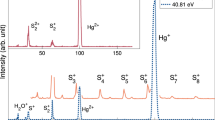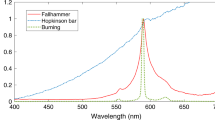Abstract
THE unexpected satellites which Imes (Astrophysical Journal, November, 1919) found beside each line in the HCl absorption band at 1.76μ, and which measurements of his curves show to have an average wave-length 16 ± 4 Å, longer than the lines which they accompany, are readily accounted for as due to the heavier of the two isotopes, atomic weights 35 and 37, of which Aston (Phil. Mag., vol. xxxix., p. 611, 1920) has shown ordinary chlorine to consist. An approximate theory shows the wave-length of the band centre to vary as the square root of the effective mass, where m1 is the mass of the hydrogen nucleus and m2 that of the chlorine atom. Taking m = 35/36 for the lighter and 37/38 for the heavier isotope, the calculated difference between the wavelengths of corresponding lines for the two isotopes comes out 13 Å. This is much larger than the differences of about 0.004 Å. which have been found between lines of the isotopes of lead (Aronberg, Astrophysical Journal, vol. xlvii., p. 96, 1918, and Merton, Roy. Soc. Proc., A, vol. xcvi., p. 388, 1920).
This is a preview of subscription content, access via your institution
Access options
Subscribe to this journal
Receive 51 print issues and online access
$199.00 per year
only $3.90 per issue
Buy this article
- Purchase on Springer Link
- Instant access to full article PDF
Prices may be subject to local taxes which are calculated during checkout
Similar content being viewed by others
Author information
Authors and Affiliations
Rights and permissions
About this article
Cite this article
LOOMIS, F. Absorption Spectrum of Hydrogen Chloride. Nature 106, 179–180 (1920). https://doi.org/10.1038/106179d0
Issue Date:
DOI: https://doi.org/10.1038/106179d0
Comments
By submitting a comment you agree to abide by our Terms and Community Guidelines. If you find something abusive or that does not comply with our terms or guidelines please flag it as inappropriate.



